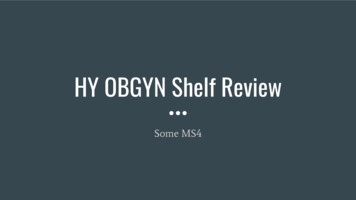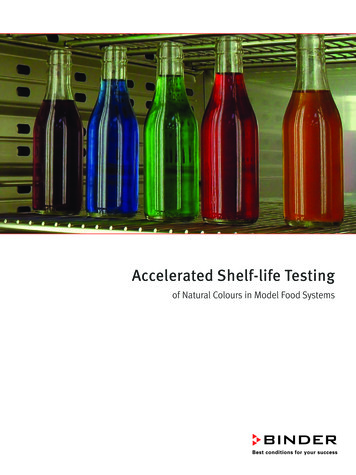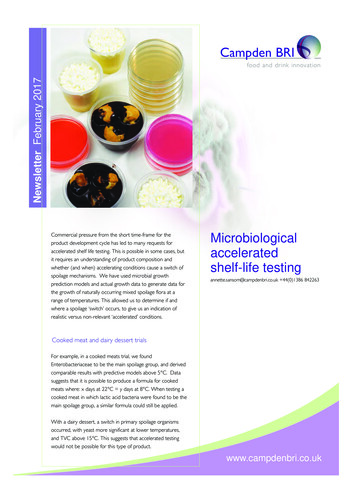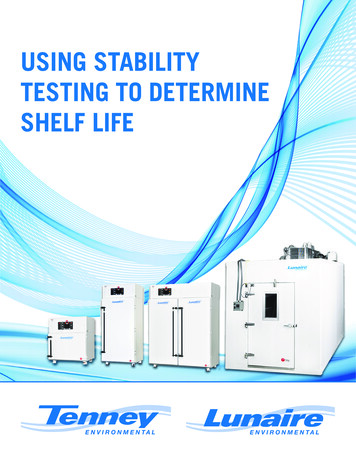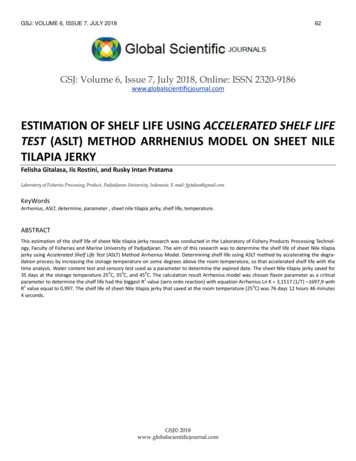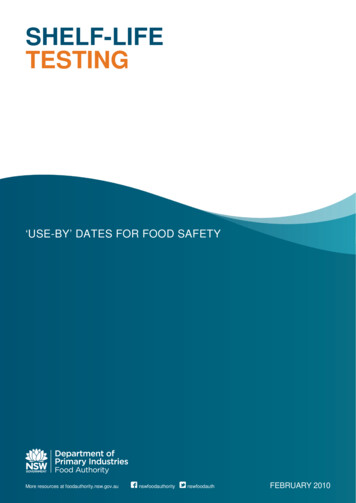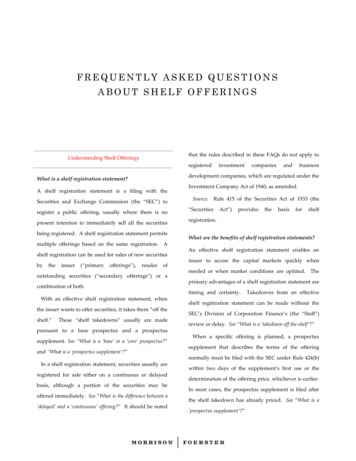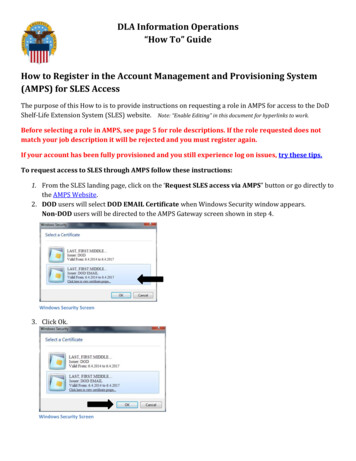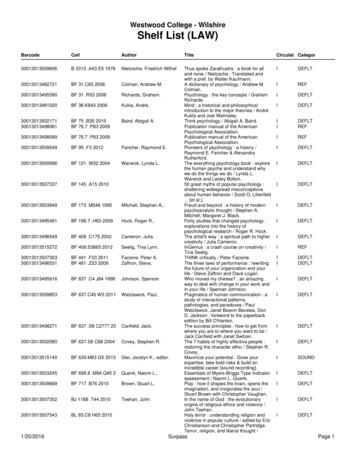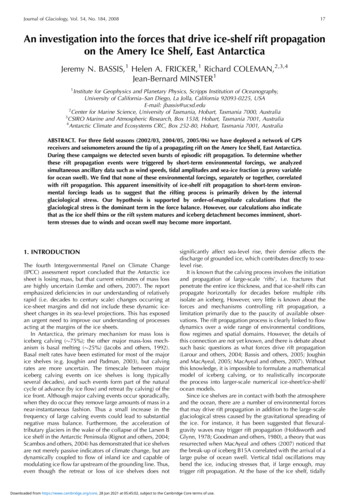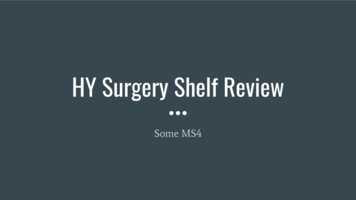
Transcription
HY Surgery Shelf ReviewSome MS4
Introduction-Welcome to M3.-The key to doing well on rotations is to study early with a decent resource (ask upperclassmen),and get through (aka do and thoroughly review) the UWorld questions and 4 NBME practiceexams.-The review videos by Emma Ramahi/Onlinemeded are also clutch. Use them!-The surgery shelf draws on material from many different fields. This makes the test seem veryrandom. There’s lots of medicine but in the grand scheme of things, there is some sort of surgicalapplication. This review set is not comprehensive, however, we will discuss some HY material.-3rd year builds on Step 1 material. Many exam questions depend on your ability to recognizedisease scripts (with unusual wording) that draw on pathophysiology you already know. It isespecially important in your studying to focus on risk factors for disease, sequential steps inmanagement of disease, and establishing a diagnosis in the context of clinical clues.
Introduction contd.-One of the strongest indicators of future success on Step 2 is strong performance onshelf exams. I would encourage you to study hard for and try to do well on theseexams. You’ll thank yourself next year. Unlike Step 1, there is no good comprehensivestep 2 resource.-To do well on NBME exams- don’t make assumptions (don’t pick an answer basedon something that is not there), pick the simple answer that has the most evidence,don’t overthink questions (just put everything together), mark questions you want toreturn to down the line (don’t spend 5 mins on a question with a first pass), study hard(the more you know, the better you’ll perform), and practice a lot (UWorld andothers).-There is a “global review” section at the end. It is a fairly long list of HY associationsyou can go through for final review.
Q165 yo M with a BMI of 32 is brought to the ED by ambulance 30 mins after hisdaughter noticed him complaining of substernal chest pain radiating to his jaw. Onarriving at the ED, he receives 325 mg of Aspirin and “some other drugs”. EKG showsST elevations in V1-6 and aVL. Cardiac cath reveals 90% stenosis of the LMCA.What is the next best step in the management of this patient?If ST elevations were observed in 2, 3, and aVF, what should be avoided?What is the best vessel employed for revascularization based on the first question?Assuming this patient presents with pleuritic chest pain best relieved by sitting up athis f/u visit 5 days later, what is the next best step in management? Few days aftersurgery (right in the CVSICU)? 4 weeks after surgery?
Q1 Key-This patient requires CABG (LMCA disease or 3 vessel disease). The InternalMammary (also known as the Internal Thoracic artery) is the best for this purposeconsidering its “durable advantages” over the Saphenous vein.-Avoid nitrates in RCA infarcts (preload dependence). Remember 2, 3, and avF for theRCA, V1-4 for the LAD, and V5-V6, 1, and avL for the LCX.-It is HY to know the different presentations of pericarditis (pleuritic CP worsenedwith supination but improved with sitting up, tx with NSAIDS);Fairly quickly after CARDIAC surgery-postpericardiotomy fibrinous pericarditis.Few days after an MI-Postinfarction fibrinous pericarditis.Few weeks after-Dressler’s syndrome (autoimmune pericarditis).
Q1 Aftermath-Consider renal failure in an individual presenting with elevated creatinine after cardiac surgery.-I would also note the following;Remember VFib as a common cause of death wrt to arrhythmias in the immediate periodsurrounding an MI.Papillary muscle rupture in the setting of a new holosystolic murmur heard best at the apex withradiation to the axilla.Ventricular free wall rupture in the setting of Beck’s triad of cardiac tamponade (JVD,hypotension, and distant heart sounds) and rapid patient decompensation.Interventricular septal rupture in the setting of a holosystolic murmur at the LLSB with either abubble study or cardiac cath showing pressure equalization b/w heart chambers.
Q2A 19 yo M is found down by EMS and brought to the ED. Cardiac auscultation reveals aholosystolic murmur at the LLSB. HEENT exam reveals retinal hemorrhages with surroundingpallor. There are red indentations under his finger.What is the next best step in diagnosis?What is the most likely murmur heard on exam?What is the offending organism associated with murmurs involving recent dental procedures?What is the offending organism associated with the patient presentation in this question?What is the offending organism associated with bacteremia after our original patient is treated?What is the next best step in the management of a 47 yo M with S. Bovis bacteremia?
Q2 Key/Aftermath-An echocardiogram is typically needed for the dx of endocarditis and most valvular disorders. ATTE is usually done first (although a TEE is an acceptable choice) w/blood cultures.-Our patient is likely a drug user with tricuspid regurgitation, most likely from S. Aureus.-Consider S. Viridans/S. Gallolyticus/S. Mutans in the setting of dental procedure endocarditis.-Consider S. Epidermidis as the offending organism in prosthetic valve endocarditis.-With S. Bovis bacteremia, the next step is a colonoscopy to evaluate for a large bowelmalignancy.-In an exam Q detailing reduced haptoglobin, low hemoglobin, and indirect hyperbilirubinemiain an individual with a prosthetic valve, consider mechanical intravascular hemolysis from theprosthetic valve.-Antibiotic prophylaxis is generally required only in those w/cyanotic congenital defects andprosthesis.
Q3 (your leg hurts, welcome to surgery!)Leg pain that is better at night with “shiny” extremitiesLeg pain that is worse at night in a 60 pack year smokerLeg pain that is relieved with leg elevationPathophysiology underlying varicose veinsNext best step in the management of an individual with leg pain with activityNBS in the mgt of an individual with leg pain relieved with leg elevationLesioned artery with no erections, buttock/thigh/calf painLesioned artery with “upper” calf pain with activityLesioned artery with “lower” calf pain with activityCalf pain in an individual with a hx of fullness behind the kneeSudden onset leg pain in the setting of an irregularly, irregular intervalLeg pain that is better when shopping at WalmartNBS in the management of sudden onset calf pain with an Afib hxShiny skin w/o hair above the medial malleolusUlcer beneath the toes with no sensation in a guy with CKDPainful ulcer beneath the toes in a long time smokerPainless ulcer above the medial malleolus in a 70 yo FABI is 1.5 in a patient with a foot ulcerFirst step in the treatment of an individual with leg pain relieved with restDrug shown to improve walking distance in the setting of PADPAD in a 25 yo Japanese female with high BP and elevated ESR/CRPNBS in the treatment of a patient with varicose veinsLeg pain with PE revealing a tortuous, palpable “cord”Unilateral leg swelling and tenderness in a pregnant woman, woman on OCPs, truck driver
Q3 KeyLeg pain that is better at night with “shiny” extremities-varicose veins.Leg pain that is worse at night in a 60 pack year smoker-Peripheral Arterial Disease.Leg pain that is relieved with leg elevation-varicose veins.Pathophysiology underlying varicose veins-incompetent valves.Next best step in the management of an individual with leg pain with activity-Ankle Brachial Index.NBS in the mgt of an individual with leg pain relieved with leg elevation-Doppler Ultrasonography.Lesioned artery with no erections, buttock/thigh/calf pain-aorta and its branches (iliac arteries. Leriche syndrome).Lesioned artery with “upper” calf pain with activity-superficial femoral artery.Lesioned artery with “lower” calf pain with activity-popliteal artery.Calf pain in an individual with a hx of fullness behind the knee-Baker’s cyst (ruptured).Sudden onset leg pain in the setting of an irregularly, irregular interval-Acute Limb Ischemia.Leg pain that is better when shopping at Walmart-Lumbar Spinal Stenosis.NBS in the management of sudden onset calf pain with an Afib hx-Heparin.Shiny skin w/o hair above the medial malleolus-Stasis dermatitis from varicose veins.Ulcer beneath the toes with no sensation in a guy with CKD-ulcers secondary to diabetic neuropathy.Painful ulcer beneath the toes in a long time smoker-ulcers secondary to PAD.Painless ulcer above the medial malleolus in a 70 yo F-ulcers secondary to venous incompetence.ABI is 1.5 in a patient with a foot ulcer-diabetes (vessels are calcified).First step in the treatment of an individual with leg pain relieved with rest-Supervised walking program.Drug shown to improve walking distance in the setting of PAD-Cilostazol (PDE inhibitor).PAD in a 25 yo Japanese female with high BP and elevated ESR/CRP-Takayasu Arteritis.NBS in the treatment of a patient with varicose veins-leg elevation and use of compression stockings.Leg pain with PE revealing a tortuous, palpable “cord”-Superficial thrombophlebitis (NSAIDS and warm compresses, no heparin).Unilateral leg swelling and tenderness in a pregnant woman, woman on OCPs, truck driver-DVT.
Q442 yo M is brought to the ED by ambulance after being “found down” by the police.He is unresponsive on presentation. At the ED, he is intubated, receives 2L of IVF, athiamine bolus, and a hanging D5W drip. 2 g of Naloxone given in repeated doses hasproduced no results. 30 mins after presentation, the resident notices that the patient’smuscles are rigid. Vitals are BP 87/48, RR 34, Temp 104.6, and pulse 123. What is thenext best step in the management of this patient?a.b.c.d.e.Administer Amiodarone.Administer 40 mg of IV Bumetanide.Administer a calcium channel blocker.Electrical cardioversion.Urinalysis.
Q4 Key-The best answer is C-administer a CCB. In this case, I am referring to Dantrolene.-This patient has malignant hyperthermia. It is HY to know its autosomal dominantinheritance and associations with ryanodine/dihydropyridine receptor mutations.-It is very common with succinylcholine and halothane administration (intubation).-The patient should be cooled down!-Watch for similar presentations (neuroleptic malignant syndrome with a hx ofhearing voices-same tx, serotonin syndrome with a hx of myoclonus and combiningSSRIs/other antidepressants/Linezolid, etc-give cyproheptadine/benzodiazepines).-Watch out for the following sequelae-peaked T waves-hyperkalemia fromrhabdomyolysis, rising creatinine-ditto. Give IVF support and maybe Sodium Bicarb.
Q565 yo M with a PMH of CAD presents with a 6 mo history of a 30 Lb weight loss. Hehas no smoking history but has regular episodes of LUQ abdominal pain that oftenlasts for 45 mins after every meal. He has been a missionary for the past 30 years withregular trips 8 times a year to Costa Rica. He has no history of osteoarthritis. Hct is45% and Fe studies are normal. Total bilirubin is 0.7 and alkaline phosphatasemeasurements are wnl. What is the next best step in the management of this patient?a.b.c.d.Trial of omeprazole.Abdominal CT angiography.Abdominal US to screen for AAA.Endoscopic Retrograde Cholangiopancreatography.
Q5 Key-The best answer is B. The most likely diagnosis here is Chronic Mesenteric Ischemia(consider in the setting of chronic postprandial pain).-In a patient with a hx of Afib that presents with sudden onset abdominal POOP to theexam, consider acute mesenteric ischemia as the underlying dx also requiring CTangiography.-There’s no smoking hx here so a screening US for AAA is not indicated. There’s noindication of biliary pathology, so an ERCP is not an appropriate first step.-A trial of Omeprazole seems reasonable but severe weight loss, normal Fe studies, hxof CAD, and LUQ pain (splenic flexure) are more consistent with mesenteric ischemiaand less consistent with PUD (pain should be epigastric).
Q6-Why is this patient hypertensive?Given the following parameters what is the most likely diagnosis?Old guy, abdominal bruit, elevated renin/A1/A2Young lady, abdominal bruit, elevated renin/A1/A245 yo M with hypokalemia, metabolic alkalosis, and decreased renin activityBuffalo hump, purple striaeNew onset Afib and proptosis35 yo F with no risk factors20 yo F with elevated arm pressures and chronic leg claudication30 yo M with episodic HTN, diaphoresis, and tachycardia35 yo chronic drinker POD #2 s/p appendectomy
Q6 Key-Why is this patient hypertensive?Given the following parameters what is the most likely diagnosis?Old guy, abdominal bruit, elevated renin/A1/A2-renal artery stenosis.Young lady, abdominal bruit, elevated renin/A1/A2-fibromuscular dysplasia.45 yo M with hypokalemia, metabolic alkalosis, and decreased renin activity-ConnSyndrome (primary hyperaldosteronism).Buffalo hump, purple striae-Cushing’s syndrome.New onset Afib and proptosis-Hyperthyroidism.35 yo F with no risk factors-OCP use (most common cause)20 yo F with elevated arm pressures and chronic leg claudication-coarctation of theaorta.30 yo M with episodic HTN, diaphoresis, and tachycardia-pheochromocytoma (don’tforget the MEN2A and 2B syndromes).35 yo chronic drinker POD #2 s/p appendectomy-ETOH withdrawal.
Q7A 66 year old man presents to a PCP to establish care. He has not seen a physicianwithin the last five years. Past medical records indicate a recent colonoscopy whichwas negative 5 years ago. He is married to his wife of 25 years and quit smoking 7 yearsago after he retired. He does not drink or use illegal drugs. He previously worked on ashipyard. Physical exam is notable only for an increased body habitus. What is the nextbest step in the management of this patient?a.b.c.d.e.Upper GI Series.IV Pyelography.Screening CXR.Cystoscopy with biopsy.Abdominal Ultrasound.
Q7 Key-The best answer is E, abdominal ultrasound.-This man has a past history of smoking so the USPSTF recommends a 1 timeabdominal US for men (not women) b/w the ages of 65-75 who have smoked in thepast as a screen for AAA. If a AAA 5.5 cm is found in men, it is de
-The review videos by Emma Ramahi/Onlinemeded are also clutch. Use them!-The surgery shelf draws on material from many different fields. This makes the test seem very random. There’s lots of medicine but in the grand scheme of things, there is some sort of surgical application. This review set is not comprehensive, however, we will discuss some HY material.
